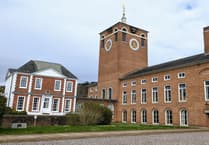WE took our morning coffee to the ford beside the Warren House Plantation and afterwards I took a long look around with my camera.
On the hedge beside the ford there were lots of long- stalked Golden rods topped with their white/grey seed heads.
This plant gives a beautiful show of golden flowers and then, when they die away, the seed heads decorate the hedgerows.
On a short length of tree branch on the hedge beside the ford was a black fungus about 10cm wide at the bottom.
This turned out to be King Alfred’s cakes and although I have seen hundreds of these fungi growing on dead wood, they are usually just black round balls, but this is the first time I have found one that actually looks like a cake, albeit a burnt one.
Growing on the damp roadside bank beside were some Orange peel fungi that look a bit like someone had peeled an orange and thrown down the skin.
This mushroom will grow anywhere, on fields, bare earth or, as in this case, beside the road.
On the edge of the plantation beside a farm track was a pile of logs roughly about two metres long.
These are what we used to call ‘pit props’ as they were destined for coal mines, but I don’t think pit props are used anymore. The thick bark on these logs had dried and separated from the wood so I lifted a piece off hoping to find some insects but there was a large toad sitting there.
Probably waiting for some insects or had already eaten them before I arrived.
I decided to walk the mile back to the old farmhouse where I saw plenty of brightly coloured bramble leaves looking very autumnal.
They certainly brightened up the hedges with their lovely reds and yellows.
I noticed something green growing on some of the hedge stones and I could see that it was one of the Liverwort family. This one grows on old tree trunks, stones and walls.
There was half a pigeon’s egg lying on the bank that had obviously provided a meal for a magpie after it was stolen from the nest.
Rather late in the season for birds to lay eggs, but wood pigeons lay at least three clutches of two white eggs every year and the sight of their stolen and eaten eggs is a common site around the edges of woodland.
I picked up some walnuts beneath the tree beside St Hugh’s Church in Quethiock and spread them on our lawn in an attempt to get a photograph of a squirrel carrying one away.
So far one or two nuts disappear overnight but no sign of a squirrel.
Walnuts are a native of Turkey and were probably brought to Britain by the Romans who grew them in orchards to provide food for their soldiers.




